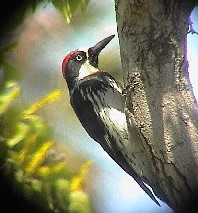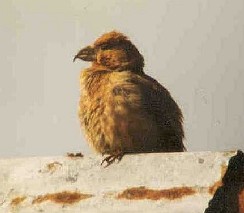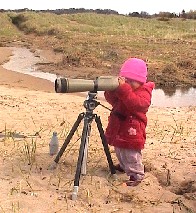





These are the bird pages set up by Stephen Welch. Besides providing a selection of links, there's some original content on the following topics:

Introduction
I have been 'avidly' interested in birds for over twenty years now. I'm an obsessive "lister" but I tend to "twitch" only rarely because I prefer to find my own birds. I see a lot of value in patch-watching and survey work (I do WEBS & BBS) and I'm a member of the Scottish Ornithologists' Club and the British Trust for Ornithology (and also at a very local level, a contributor to the BTO's "Garden Birdwatch" scheme). Over the years I've contributed directly to about 25 local bird reports in the UK & Ireland, including 12 in Scotland, as well as indirectly for these and other areas via Birdguides and BTO Birdtrack submissions etc.
I did most of my early birding near my parent's home in Banchory on Royal Deeside, Scotland. This is a great area for birds, and I've seen about 200 species in Grampian region. I have visited/spent some of my holidays on Skye (1977, 1978, 2001), Harris & Lewis (1981, 2001), Rhum (1988), Orkney (North Ron) (1980,1989), Shetland (1990), the Faroe islands (1990), Cape Clear Island (County Cork) (1996), Bardsey Island (1997), around Land's End in Cornwall (1998), Anglesey/North Wales (2000), the Outer Hebrides (2001), Pembrokeshire (2001) and North Devon (2003). I also had my first taste of tropical birding on our trip to Nigeria in November 2002.
A summary of some of my (modest) records is included. My best find was a Glossy Ibis (Plegadis falcinellus), a native of the Mediterranean, which I came across at the Loch of Strathbeg, Grampian, on 27th September 1986.
I love seawatching and admire the abilities of seabirds such as the Storm Petrel. On 28 October 1998 I watched them watched passing Gwennap Head at Porthgwarra in Cornwall even though the wind was gusting to well over 50mph and I was unable to stand up! Despite being only as long as a House Sparrow, they spend their entire life out on the open ocean, only ever coming ashore, at night, to nest on remote islands. They can deal with storms like this by skilfully using the troughs of the waves to shield themselves from the brunt of the wind.
I'm also interested in gulls and I've studied the movements and numbers of large gulls near my home in NE Scotland over many years, and more recently also in Hertfordshire, as described on my local patches page. There's been a lot of media hype recently about the "threat" posed by gulls which are made out by some to be a dangerous "pest", see e.g. this petition to the Scottish Parliament. This needs to be countered by those who understand more about these tough and resourceful species and recognise that their lifestyle, adapted around man's activities, does not make them any less a creature than any of our more popular wild birds.

Studies
One of my main passions in birding is finding out more about birds - hence my involvement with survey work, etc. I have also undertaken a number of personal studies over the years, including:

Garden birds
For those who don't have time to get out to look for birds, observation of garden wildlife can also be a very rewarding hobby. Regular observation can contribute to long-term scientific research on bird populations, e.g. through the BTO's "Garden Birdwatch" scheme, and can even turn up rarities - e.g. a Serin over our garden in Watford on 26th August 2001. I've developed some pages on garden birding, with weekly records analysis and a daily log.

Incredible birds
I find records of rare birds fascinating and I've put together my own list of some of the most incredible bird records of all time, but mainly focused on the UK and Western Palaearctic. Separate pages provide some more information about the recent occurrences of Swinhoe's Petrel and Elegant Tern in the North Atlantic, and another page lists recent articles on the Slender-billed Curlew following the recent acceptance of the 1998 Druridge Bay record.

Persecution
A sadder aspect of bird-watching is where man's greed and commercial pressures combine to put rare species under pressure and in some cases lead to decimation of native bird populations. In Europe these issues are particularly acute in some Mediterranean countries, such as Malta and Cyprus, where there has been a long tradition in killing vast quantities of migrant birds by a variety of means. For example, it is estimated that over 500 million birds were shot or trapped in Mediterranean counties in 2001, the vast majority of which are "fully protected", i.e. it is illegal to kill them.
But even here in the UK, rare species are routinely persecuted, especially on sporting estates. Scientific studies suggest that this is a very serious problem with a significant percentage of estates engaging in persecution. And egg collecting still impacts on the survival of our rarest breeding species.
Pressure is now being applied to those countries which turn a blind eye to illegal persecution of birds, via various international campaigns. This may be particularly pertinent in some cases where the nations concerned are applying for full membership of the EU. I am developing a new page providing some more information about these matters.
One of the worst incidents recently was on 10 May 2002 when 900 Honey Buzzards gunned down by Maltese hunters on a single day. The slaughter continued autumn 2002 and 2003 with raptor camp volunteers reporting reduced police presence and most migrant Honey Buzzards being shot down. Go to the Proact Malta campaign if you want to do something about this! See also my persecution page for more info.

Cats
While we devote our energies to conservation of birds and wildlife we face a formidable foe in the guise of the domestic cat. There are orders of magnitude more cats than foxes in Britain and due to the unthinking attitudes of many cat owners they have a huge impact on our wildlife - killing an estimated 275 million animals per year including 55 million birds - make that nearly 10 dead animals per second every day of every year and one bird for every person in the UK (see The Mammal Society report on Predation of wildlife by domestic cats in Great Britain). A similar estimate from the US is 300-500 million birds kills per year (see page 11 of this document).
We have a lot of trouble from cats in our own garden and recently witnessed one breaking the back of a young rabbit at my workplace then abandoning it. Whilst I acknowledge that cats are intrinsically beautiful and amazing creatures, and understand those who desire to keep them as pets, many cat owners seem to be irresponsible and are content for others to clean up the mess after them (e.g. disposing of dead rabbits, birds and other such debris). Only a tiny minority are fitted with bells.
There are guidelines for responsible cat owners at the foot of the "Look what the cat's brought in!" survey page.

Other links, mainly bird news
There's lots of other bird information on the web and one of the best sites
for general bird information is the Fatbirder website which has over 600 pages and 15000 links
covering birding across the world. Some other sites providing bird news are
listed below. The online library available from birdguides is a wonderful resource for information about species occurring in Britain (distribution maps, colour photos etc.). All of my own
pages are listed here too, marked with a pog (![]() ) symbol.
) symbol.
General
UK general bird news
UK local bird news
UK observatories
European bird news
Rest of the world bird news and links
Research and campaigns
Bird images and sounds etc
My bird pages (full list by topic)

Updated 28/8/07